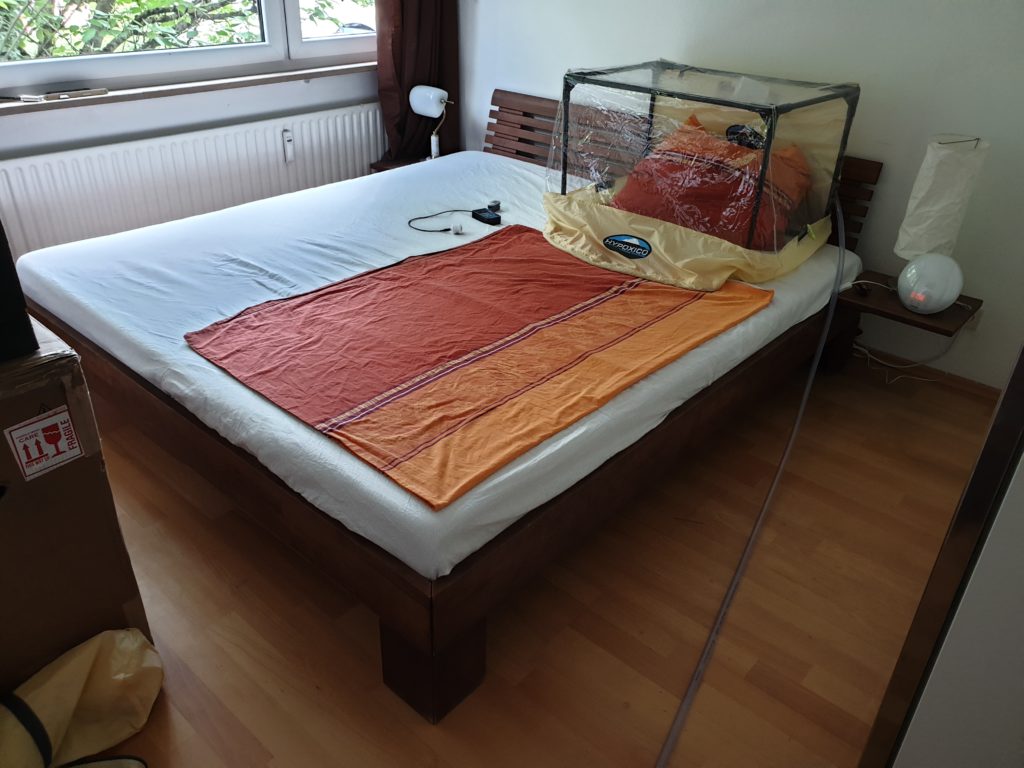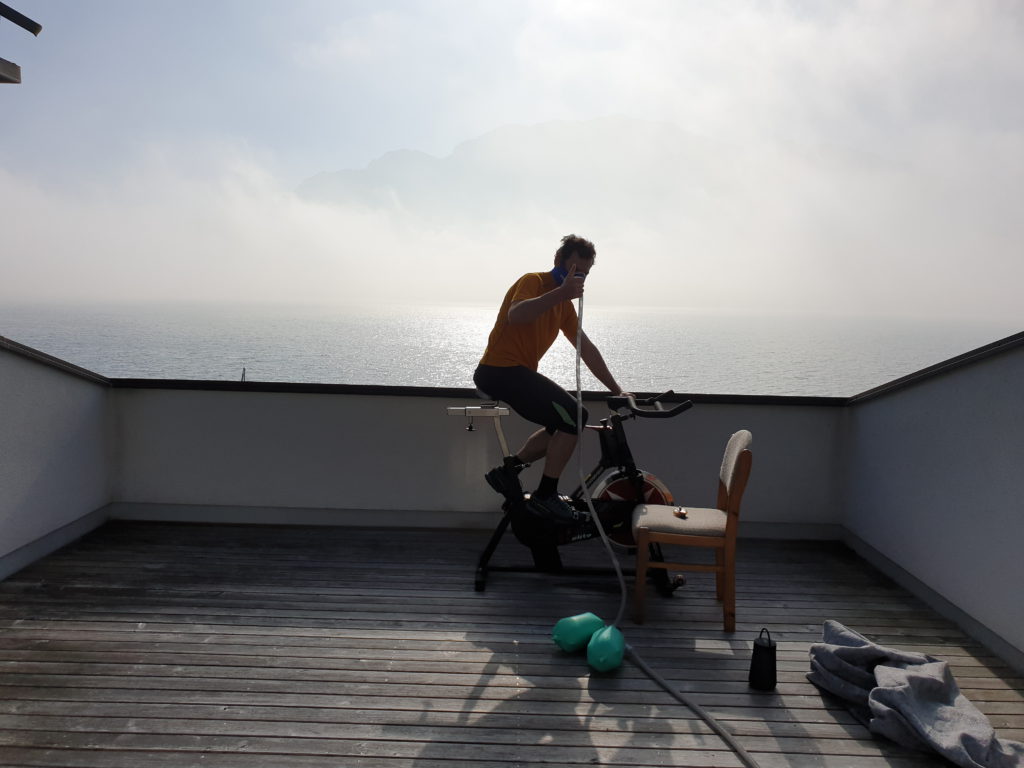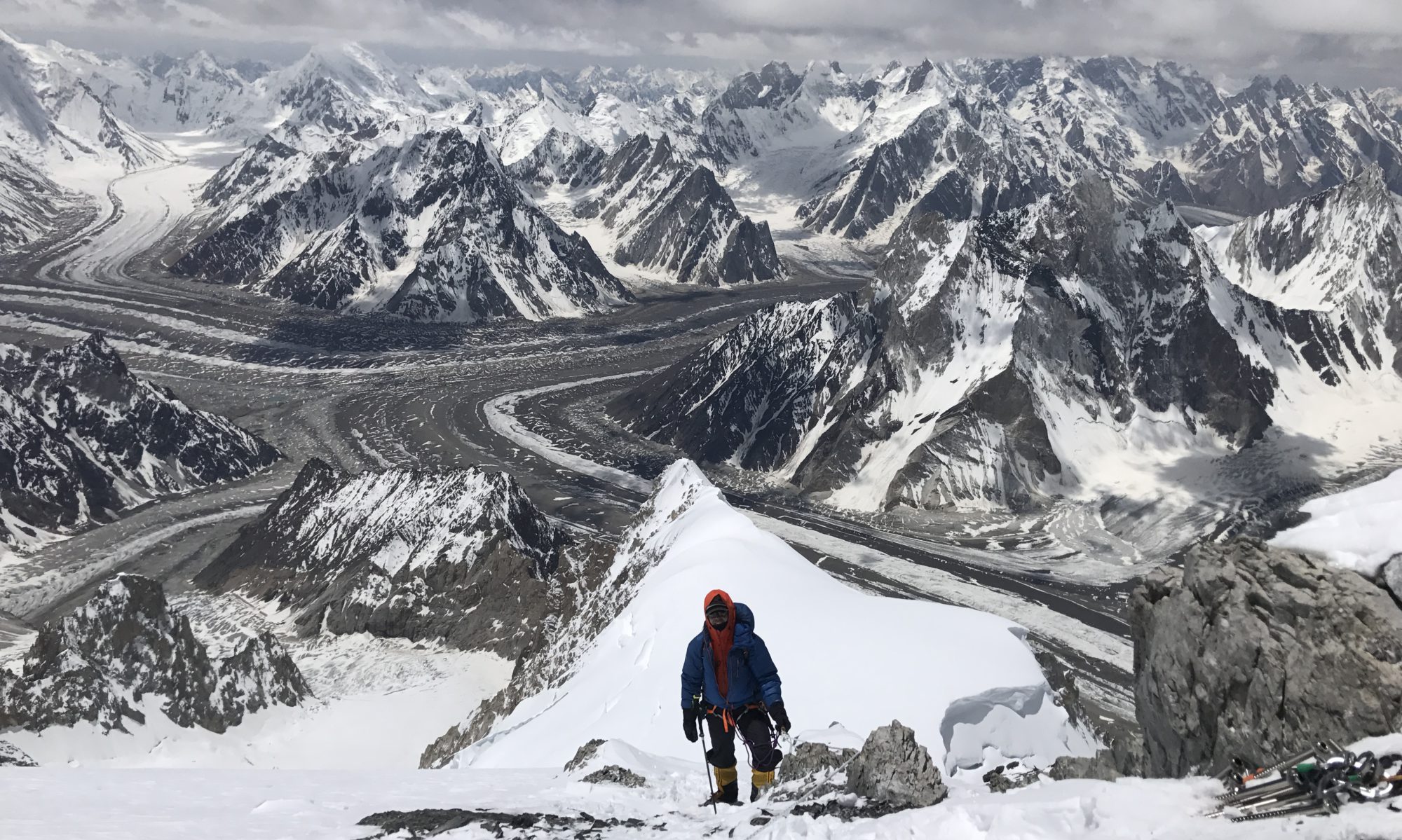Before I continue the travel blog I was asked by several people to give more information on the acclimatization thing. Those who followed me already on the Pakistan and Everest expedition in the last two years will already know about this. I will simplify things and leave out some details to not overcomplicate things…
Basic knowledge about the human body and oxygen
So, as it is well known our human bodies need oxygen to function. It is needed to enable the “cell powerplants” which (simplified) take carbohydrates and fats to transform them into glucose and then ATP, the basic fuel for the cells, which is then burned with oxygen to provide energy, along the way producing CO2. The energy powers e.g. the brain (it needs up to 30% of the whole energy in the body!), muscle cells, basic cell mechanisms like ion pumps, signal transmitters etc. About 40% of the energy is needed for the own cell survival, 60% of the energy for their proper tasks, i.e., signal transmission.
There is an alternative energy producing mechanism which works without oxygen by burning ATP into lactic acid, but this only works only as a “peak” provider and only for a short time. Lactic acid causes the characteristic muscle burn and cramps which you know when you have exercised hard. But for the basic body functioning, enough oxygen is essential.
So where do we normally get the oxygen from: Clearly from the air we are breathing in. The air surrounding us contains about the following gases: 21% oxygen, 78% nitrogen, 0,03% CO2, and 1% rare gases (like argon). Our body uses up oxygen in the cells, producing CO2 and H2O (water) along the way. This oxygen deprived and CO2 rich blood diffuses into the blood in the capillary vessels where it is then transported in the veins to the right heart atrium and chamber, from there it is transported to the lungs where the oxygen deprived blood gets saturated again with oxygen in the lung alveoles, and CO2 is taken out and breathed out, from the lungs it then transported back to the left heart atrium and chamber from where the oxygen rich and CO2 deprived blood is transported via aorta and the arteries to the brain and various body parts where the oxygen / CO2 exchange mechanism via the capillaries can start again. The transport of oxygen itself in the blood takes place via the erythrocytes, also known as red blood cells. They contain a molecule called haemoglobin which can pick up oxygen in the alveoles, transport O2 in the blood and then diffuse it again to the cells in the capillaries.
Specific challenges at high altitudes
So far, so good. What is the challenge then for high altitudes? For this we need to talk about so called partial gas pressures. At sea level, the assumed norm pressure is 1013 mbar (hPa) (will change with weather), at Munich we will usually have around 950 mbar. Partial pressure of a gas is now simply multiplying the total pressure of the gas mixture we are looking at with the proportion of the gas in the mixture. That is, for oxygen we would for example take 950 mbar x 21% and get 200 mbar. This is the partial pressure of O2 at Munich with a total air pressure of 950 mbar. As most of you will now, air pressure drops the higher we get. This works as an exponential function, so at 5000 m above sea level pressure has dropped to about 50% of the pressure from sea level, and at Mount Everest 8848 m pressure has dropped to about 33% of sea level pressure. Now it is important to note that the gas proportions within the air do not change with altitude. That is, at Mount Everest the air still contains about 21% of oxygen, albeit at a much lower pressure. Thus, the partial gas pressures drop accordingly with the total pressure. At Mount Everest, the partial pressure of oxygen is about 33% of the partial O2 pressure at sea level.
This drop of partial O2 pressure is what you feel when you go up a higher mountain, e.g. Zugspitze or Mont Blanc: you will get short-breathed and you will not have the usual amount of energy for exercise – less oxygen provided means you can burn only less ATP to provide energy. In addition to the drop in partial O2 pressure in the air, the partial O2 pressure drops even further a bit when working its way through the body, so when the O2 finally arrives in the cell the partial O2 pressure is even a bit lower than it was in the air we were breathing in.
Now, being short-breathed would only by an annoyance – but now we are coming to the true challenge of high altitudes. With partial O2 pressure dropping, the basic cell functioning mechanism are more and more challenged. Id est, we are not only short-breathed, but basic things like ion pumps, signal transmitting, brain functioning will be more and more challenged as there is less and less energy. And finally: At Mount Everest altitude the partial O2 pressure that finally arrives at the cells is so low that it is at the very physiological limit at which human life can be sustained at all. As mentioned above, about 40% of the energy produced are needed for the cell survival, 60% for the signal transmission tasks. Obviously, with a lack of oxygen, the cell will first cut down on its signal transmission tasks etc. before cutting down on its own survival energy. And that is, with all non-essential functions already reduced to zero and only the basic essential functions still on. That is the reason why only very few people are able to reach Mount Everest summit without supplemental oxygen, and also only if they are genetically at an advantage, if it is nice weather and if there is a high pressure weather around Mount Everest. And if Mount Everest was only 200 or 300m higher, nobody could reach its summit without supplemental oxygen.
Acclimatization
Luckily, the human body has ways of coping with lack of oxygen: This is called acclimatization. Otherwise, we would not be able to climb those high mountains. For altitudes up to 2500m, no acclimatization is usually needed. The body can cope with these altitudes with short-term adjustments like increasing breathing frequency. Starting at 2500-3000m, most people will start feeling altitude effects and an acclimatization process is needed, otherwise altitude sickness will set in (more or less severe).
Acclimatization mechanisms
From the above explanations, three basic drivers can be identified which need to be improved in order to cope with the lack of oxygen at altitude
- Oxygen intake
- Oxygen transport
- Oxygen usage
Oxygen intake simply means breathing more quickly, i.e. hyperventilating. The breathing regulation notes the lack of oxygen and increases the breathing frequency. This works immediately and does not take much time. Only problem is that this breathing regulation does not work well in the night, that’s why many people do not have problems during exercise where they are hyperventilating, but at night the breathing frequency drops back to “normal” and that’s when people develop altitude sickness. Fun fact: The Sherpa people from Nepal are genetically better suited for altitude as they have a natural hyperventilation breathing rhythm
Oxygen transport: This means producing more erythrocytes so that per ml blood more oxygen can be transported. This process however takes time, weeks and months
Oxygen usage: This means that the capillaries and cells adjust to the lower oxygen offer by improving capillarization and cell powerplant functions. This also takes weeks and months to develop.
Mechanism 2 and 3 are essential to adjust to higher altitudes, as hyperventilation alone will not suffice at really high altitudes, and they are the reason why acclimatization takes up so much time.
For which altitudes can the body acclimatize?
Basically, for altitudes up to 5000-5500 m the human body can fully acclimatize. That is, given enough time the body will adjust so that life can be sustained indefinitely, albeit at a slower pace. That is also the reason why there are no permanent human settlements above 5500m. Above 5000-5500m, only a partial acclimatization can be achieved, and only temporary stays are possible. The higher up, the shorter. At 6500m, life could be sustained for several weeks but with a gradual decline. Above around 8000m, the so called death zone, even with perfect acclimatization, life can be sustained only for a few days (without supplemental oxygen). Someone without any acclimatization would fall into a coma and die in a short time at this altitude.
How does acclimatization work?
The basic idea is to “tease” the body with a lower oxygen offer, e.g. going up to altitude, and then going back to normal altitudes to give the body time to work on the tease and start working the acclimatization mechanism.
So a classical acclimatization routine e.g. for Broad Peak might look like this:
- Slow and gradual ascent to basecamp, with rest days, to give the body time to start working the acclimatization. The basic rule is to increase “sleeping altitude” not more than 500m per day
- After arrival in basecamp, take some days rest to adjust to the new altitude. By the way, basecamps are always set up below 5500m because only then you can still have an acceptable rest
- After some rest, first acclimatization rotation: Go up to camp 1 at 5700m, sleep there, go up the next day to camp 2 at 6400m, but only touch, no sleeping, go back down to basecamp
- Take some rest days
- Second acclimatization rotation: Go up to camp 2, sleep there, go up the next day to camp 3 at 7000m, but only touch, no sleeping, go back down to basecamp If everything went well and you feel fine, you should be acclimatized for Broad Peak summit 8051m. For a higher mountain such as K2 8611m you might want to do one night a 7000m and touch at least 7500m or 8000m
- But such a classical acclimatization routine takes a lot of time. For Everest, normally eight weeks are assumed necessary.
Potential high altitude complications
Potential complications of altitudes and problematic acclimatization: Altitude sickness. Without proper acclimatization people will develop altitude sickness. The first symptoms are headaches, exhaustion, dizziness, nausea, difficulties sleeping. A slight headache is quite normal and might be treated with a mild painkiller such as Ibuprofen. If the headaches get worse and do not go away with pain killers it is clear sign you are developing a severe altitude sickness. The first and most important treatment is a quick descent to lower altitudes. If altitude sickness is not treated quickly, it can develop into severe illnesses like high altitude pulmonary edema and high altitude cerebral edema which often end with death.
Pre-acclimatization: The smart way
As mentioned above a “classical” acclimatization routine takes a lot of time with boring acclimatization rotations, lots of time in basecamp. This is very very annoying, at least for me. The idea is now to do some acclimatization at home, parallel to your “normal” life. At first, you might think to go into a pressure chamber where you can gradually lower the pressure to simulate the higher altitudes. This would surely work, but a pressure chamber is cumbersome and expensive. Also, the process of pressurizing and depressurizing takes up a lot of time.
Instead, it was discovered that the body starts the same acclimatization process if subjected to lower O2 proportions at normal pressure. That is, the body reacts pretty much the same if subjected to regular air at 50% sea level pressure (i.e. simulating 5000m altitude) or to air which contains only 10.5% of O2 instead of 21% at normal sea level pressure. And technically, it is much easier to take oxygen out of the air than building a pressure chamber.
What you need then is:
- A generator which is able to draw oxygen out of the air (and replace it with nitrogen)
- A tent in which you can sleep and breath the hypoxic air with lower O2 proportions at normobaric pressure, as if you were sleeping at altitude
- A mask for active hypoxic training, i.e., do exercise with hypoxic air – as if you were going up the mountain at altitude
And then you follow a “normal” acclimatization strategy: You start sleeping in the tent at lower altitudes and then gradually increase altitudes. Same for the active training: Start your units at lower altitudes and then increase. I started with a sleeping altitude of about 3000m and in the end spend several nights at around 7000m. For the active training, I did 40-60 minutes units four to five times a week as interval training, that is five minutes high intensity and five minutes low intensity. I started also at around 3000m, did the main part of the training at around 4500-5000m and in the end did some units at 7500m. But those units were rather at a snails pace ?.
And that’s how the altitude tent for sleeping looks like. It is a head tent style, you sleep with the head and parts of the upper body in the tent. The tube from the generator is simply put into the tent and “crowds out” the normal air. The advantage compared to a full tent is that you can reach the required altitude much faster as there is less normal air to be crowded out. Also, it is less hot and humid. And it is quite easily transportable if you go on travel. The generator though is a bit a pain in the ass as it is large and heavy… All that said, the tent is of course not very romantic ?.

For the active training, I used a Bowflex trainer at home which is a mixture of a stepper and bike, and for travels I used a spinning bike. The picture was btw not taken at the sea, but at beautiful Attersee lake in Upper Austria in the morning :).

With this pre-acclimatization method, I was able to reach Everest summit three weeks after departure last year. So it works and I am a big believer in this method. It enables you to pass more time at home in your normal social environment with family and friends, you can continue your work albeit at a reduced pace, and you spend less boring time in base camp or at boring acclimatization rotations. Furthermore, you arrive better rested and with more power at basecamp. But this pre-acclimatization does not come for free. You want to have around 250-300 hours under hypoxia to achieve the desired acclimatization. Six weeks before departure I started the pre-acclimatization, with six nights per week sleeping in the hypoxia tent, and doing about 4-5 hypoxia training sessions per week. In addition, I did several tours in the higher alpine mountains, for example at Großglockner or at Mont Blanc. But overall an incredible gain compared to a “classical” acclimatization! Big thanks to Lukas Furtenbach for bringing this method to Europe.
